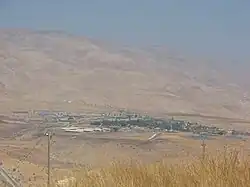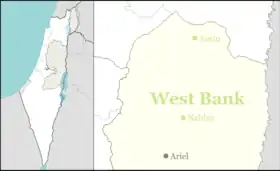Hamra (Israeli settlement)
Hamra (Hebrew: חַמְרָה, lit. 'Red Soil') is an Israeli settlement organized as a moshav in the West Bank.[2] Located in the Jordan Valley and covering 3,500 dunams, it falls under the jurisdiction of Bik'at HaYarden Regional Council.[2] In 2021 it had a population of 273.[1]
Hamra | |
|---|---|
 | |
 Hamra | |
| Coordinates: 32°11′56″N 35°26′6″E | |
| District | Judea and Samaria Area |
| Council | Bik'at HaYarden |
| Region | West Bank |
| Affiliation | Agricultural Union |
| Founded | 1971 |
| Population (2021)[1] | 273 |
The international community considers Israeli settlements in the West Bank illegal under international law, but the Israeli government disputes this.[3]
History
The moshav was founded in 1971 and was initially named Atarot, before being renamed after nearby Tel Hamra.[2]
According to ARIJ, Israel confiscated land from two nearby Palestinian villages in order to construct Hamra; 1,370 dunams from Furush Beit Dajan, 192 dunams for a military checkpoint close to Hamra,[4] and an unspecified amount from Beit Dajan.[5]
In 2020 a family in the nearby Humsa al-Tata village, located above the Hamra checkpoint, was ordered to destroy their home and concrete castings around contiguous structures, including a well and olive trees, after the Israeli government declared it was on an archaeological site. The owner stated that they had lived there since their great-grandfather's time and no-one had ever heard of antiquities on their land.[6]
References
- "Regional Statistics". Israel Central Bureau of Statistics. Retrieved 22 February 2023.
- "חמרה". Archived from the original on 2014-10-14. Retrieved 2014-08-22.
- "The Geneva Convention". BBC News. 10 December 2009. Archived from the original on 12 May 2019. Retrieved 27 November 2010.
- Furush Beit Dajan Village Profile Archived 2018-01-27 at the Wayback Machine, ARIJ, p. 15
- Beit Dajan Village Profile Archived 2016-03-04 at the Wayback Machine, ARIJ, p. 15
- Hagar Shezaf, When an Archaeological 'Find' Can Evict Palestinians From Their Home Archived 2021-10-29 at the Wayback Machine, Haaretz, 23 June 2020.